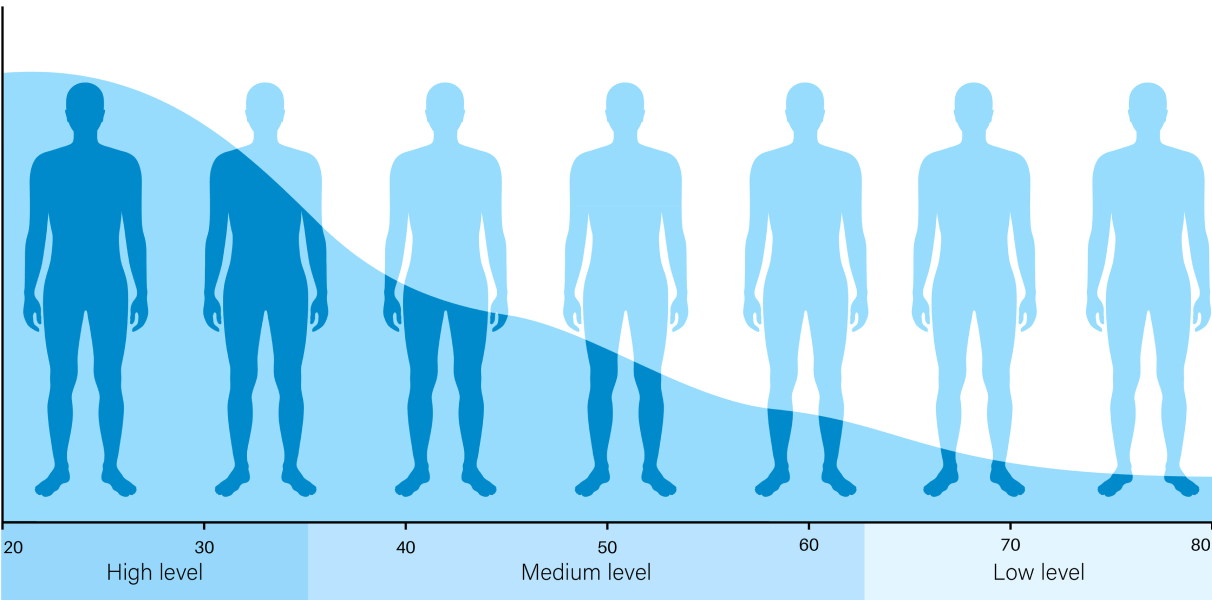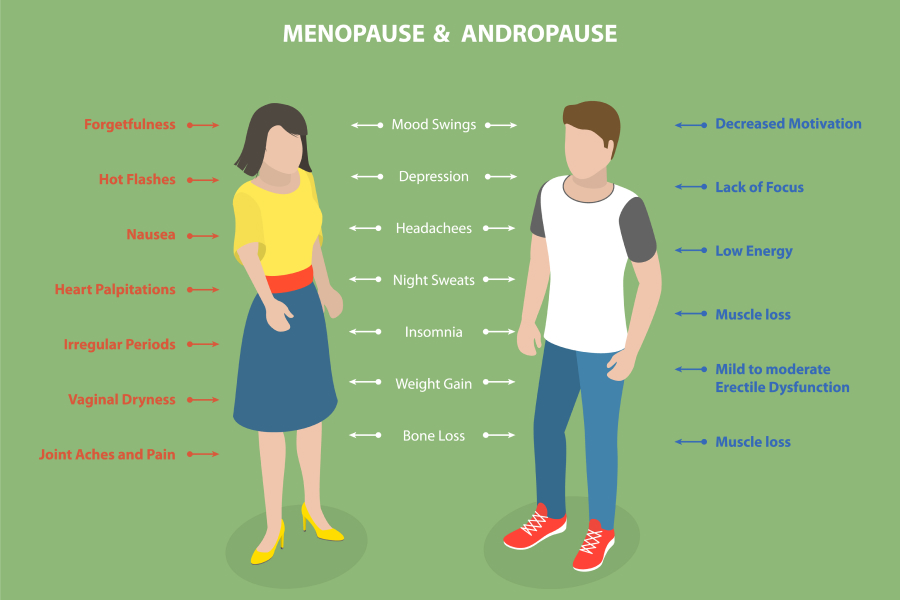Am I Going Through Male Menopause?
Andropause is a collection of symptoms, including fatigue and a decrease in libido that some middle-aged or older men experience due to a gradual decline in testosterone levels.
Known as age-related low testosterone or late-onset hypogonadism, andropause symptoms are also often referred to as ‘male menopause.’ As the primary male hormone, testosterone declines as men age.
Andropause describes age-related hormonal changes in men that are usually more gradual and less well-defined as womens’ menopausal symptoms. Yet, andropause for men can adversely affect multiple organ functions and quality of life – so it really needs to be monitored and treated.
Testosterone Level by Age (Men)

Reduced testosterone begins after the age of 30 for men, with levels dropping about 1% per year.
At NW Regen, we work with male patients who are experiencing low testosterone. They are finding great relief and reversal of symptoms with hormone-replacement therapy and natural treatments for erectile dysfunction and weight loss.
Most men come into our office first for some exercise-related injury or joint damage.
It’s only after they share candidly about the following that we turn the conversation to testosterone.
Are you experiencing:
- Reduced sex drive,
- gGain in weight,
- Lack of energy, or
- Frustration or anxiety about the changes in your sex life?
Lots of men are in the same boat. This is one reason we wrote this article, becuase we should talk sooner than later.

At NW Regen, we’ll test to discover your hormone levels as well as other baseline measurements
that will help you to put your changing health first. Contact us today to get your labs done.
What Are Symptoms of Andropause in Men?
For some men, the symptoms of andropause become noticeable around middle age (40–60 years old). Not all middle-aged or older men experience symptoms, but those who do might notice:
Physical Changes:
- Reduced muscle mass and strength
- Decreased bone density
(Osteopenia or osteoporosis) - Low energy levels and fatigue
- Insomnia or poor sleep quality)
- Increased body fat – can lead to
- Enlarged breast tissue (gynecomastia)
Sexual Changes:
- Reduced libido (sex drive)
- Erectile dysfunction (difficulty achieving or maintaining an erection)
- Decreased sexual performance
- Reduced sexual satisfaction
Emotional Changes:
- Mood swings or irritability
- Depression or feelings of sadness
- Reduced motivation
- Lowered self-confidence
Cognitive Effects:
- Difficulty concentrating
- Memory problems
- Reduced mental sharpness

We’re here for you: Contact NW Regen to get your labs done and learn where you’re at with your testosterone.
How Does Andropause Compare to Menopause?
Both menopause and andropause occur as people age and are associated with hormonal changes. Menopause is marked by a sudden drop in estrogen and progesterone, while andropause involves a gradual decline in testosterone levels over many years. While menopause completely ends a woman’s reproductive ability, andropause does not affect a man’s ability to father children.
Both conditions share a lot of symptoms, as this illustration shows. If you’re experiencing mood swings, possible depression, headaches, night sweats, insomnia, weight gain, and bone loss — you’ve actually got a lot in common with the opposite sex, because each experiences decreased hormone production as we age. There is help availalbe through regenerative medicine to address these symptoms and change some of the underlying causes.

More pronounced symptoms can be experienced by women, like hot flashes, yet many of the symptoms of andropause are also shared by menopausal women, like mood swings, bone loss, weight gain. Talk about what you’re experiencing with your physician.
What Makes Me Susceptible to Andropause?
Andropause primarily affects men aged 40 and older, though onset and severity vary widely among individuals. Factors influencing the likelihood and intensity of andropause include:
- Genetics
- Lifestyle factors like diet, exercise, and stress levels
- Chronic health conditions (e.g., diabetes, obesity, or cardiovascular disease)
- Alcohol or substance use
How Do You Treat Andropause?
Andropause is not a disease but a natural part of aging. However, symptoms can sometimes interfere with quality of life. If so, first consult with a healthcare provider for guidance. You can schedule time with Dr. Wood to get your labs done, and speak with him 1:1 about symptoms and treatments for what you are experiencing.

While andropause is a natural part of aging, it doesn’t have to disrupt how you feel about yourself or get in the way of you being comfortable and happy with your life and body.
Treatments may include regenerative therapies for specific symptoms:
Hormone replacement therapy can help restore testosterone levels, but it should be used cautiously under medical supervision due to potential risks (e.g., heart disease, prostate health concerns). Get testosterone levels checked by a doctor before starting TRT. And know in advance that you’ll need to work with your healthcare provider to monitor your health regularly during treatment (blood tests, PSA levels, and red blood cell count).
Hormone Replacement Benefits
- Increases energy and reduces fatigue
- Enhances mood and mental clarity
- Boosts libido and sexual performance
- Promotes muscle growth and strength
- Improves bone density
Risks and Considerations
- TRT may Increase risk of cardiovascular issues (e.g., heart attack, stroke).
- Affect prostate health (e.g., enlarging the prostate or aggravating prostate cancer).
- Suppress testosterone production.
Lifestyle changes that may be recommended:
Counseling or therapy to address mood-related symptoms.
Regular exercise (strength and aerobic training)
A balanced diet that is rich in nutrients
Stress management and adequate sleep
Get Your Labs Done!
The beginning of the year is a great time to schedule an appointment with your healthcare provider and get your bloodwork done. Dr. Wood can evaluate testosterone levels and provide tailored recommendations and regenerative treatments.
NW Regen
We offer regenerative and interventional medicine – tailored to empower you with a more vibrant, active lifestyle.


